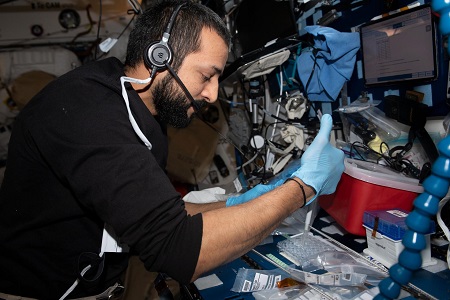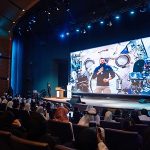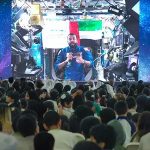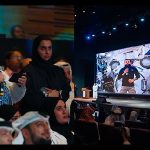AlNeyadi has devoted a585 hours to conducting various ground-breaking experiments and nominal tasks aboard the International Space Station.
 Sultan Al Neyadi has achieved the mid-mission milestone and becomes the longest-serving Arab astronaut, having spent over three months aboard the International Space Station (ISS). This journey signifies a historic milestone for the UAE, as Al Neyadi has skillfully navigated through a series of firsts, setting a list of unprecedented achievements.
Sultan Al Neyadi has achieved the mid-mission milestone and becomes the longest-serving Arab astronaut, having spent over three months aboard the International Space Station (ISS). This journey signifies a historic milestone for the UAE, as Al Neyadi has skillfully navigated through a series of firsts, setting a list of unprecedented achievements.
Commenting on the momentous occasion, Salem Humaid AlMarri, Director General, MBRSC, said: “Congratulations to Sultan Al Neyadi as he completes half of his six-month mission on the ISS. The dedication, resilience, and strength Sultan has demonstrated in consistently achieving one milestone after another truly reflect the calibre of astronauts we cultivate here in the UAE. He represents the core values of the MBRSC by consistently focusing on knowledge-building initiatives for the next generation and appreciate his commitment towards the community and student outreach. As we look forward to the next three months, we are confident his journey will continue to make us proud and inspire future explorations.”
Adnan AlRais, Mission Manager, UAE Astronaut Programme, added: “Congratulating Sultan Al Neyadi for completing an impactful three months aboard the ISS. Sultan’s dedication to science has seen him make remarkable strides during this period. With another three months ahead, we are eagerly waiting for more groundbreaking research projects. UAE Space Sector, keep moving forward. Paving the way for the future of UAE’s space sector, this mission serves as a powerful catalyst, fueling our drive towards unprecedented advancements in space exploration.”
Sultan Al Neyadi ventured out of the International Space Station (ISS) and completed his spacewalk.
With the conclusion of the mission task on April 28, the UAE commemorates Al Neyadi as the first Arab to undertake a spacewalk during Expedition 69, currently underway on the ISS.
Four live calls and three HAM radio calls with astronaut Sultan Al Neyadi, gave students and the community insights into the longest Arab space mission in history.
Close to 5,000 people have taken part in the past four editions of the event, giving attendees a glimpse into Al Neyadis life on the ISS and the opportunity to interact with him. The first event in the series was held at the Dubai Opera, followed by the second for media at the Museum of the Future. The third edition was held in Mauritius, while the fourth session was held at the United Arab Emirates University in Al Ain.
Under the same A Call from Space event, three ham radio sessions have been successfully completed in collaboration with the Emirates Amateur Radio Society (EARS) and Emirates Literature Foundation (ELF). Around 100 students from various schools around the UAE participated in these events, which aim to bring space closer to the community.
Sultan Al Neyadi along with his Crew-6 crew members successfully completed the mission to relocate the SpaceX Dragon spacecraft on the International Space Station (ISS).
He marked his first space birthday on May 23. The treasured ISS tradition was well celebrated when Sultans crew members surprised him with two homemade cakes. A Maple Muffin top cake from the USA crew, a Cinnamon Bun with yoghurt and dry fruits from the Russian crew.
Al Neyadi has devoted 585 hours to conducting various ground-breaking experiments and nominal tasks aboard the International Space Station.
Al Neyadi is currently engaged in an ongoing mission, donning a Bio-Monitor vest and headband, diligently tracking his cardiovascular system amidst routine crew activities. He has been an integral part of the team, preparing for the upcoming spacewalk that will be conducted by Stephen Bowen and Warren Hoburg. Along with other crew members, he has been working on Canadarm2 robotic arm manoeuvres through computer simulations which is a critical component of the forthcoming solar array installation work.
He sets up hardware for the Monoclonal Antibodies Protein Crystal Growth-2 (PCG2) experiment aboard the ISS. The PCG2 experiment analyses the process of crystallising biotherapeutics in microgravity, potentially improving in-space and Earth production techniques and shortening the development cycle for new medicines. He worked on a pair of space biology studies with Ax-2 Mission Specialists Ali Alqarni and Rayyanah Barnawi.
Human research activities have dominated the crews schedule on the ISS, which included ultrasound scans, vision checks, and hearing exams. Al Neyadi using standard medical imaging gear found in an optometrists office on Earth. Space physics was also part of the research agenda, as scientists and engineers sought to understand how Earth-created materials react to microgravity conditions.
Al Neyadi worked on cargo work, offloading some of the 6,200 pounds of new science experiments, crew supplies, and station hardware delivered by the SpaceX Dragon resupply ship.
Al Neyadi demonstrated the use of a 3D printer to manufacture tools, components, and experiments on the orbital outpost. Part of the experiment entailed collecting and stowing samples in a science freezer for a study exploring the biomanufacturing of pharmaceuticals in space.












































































